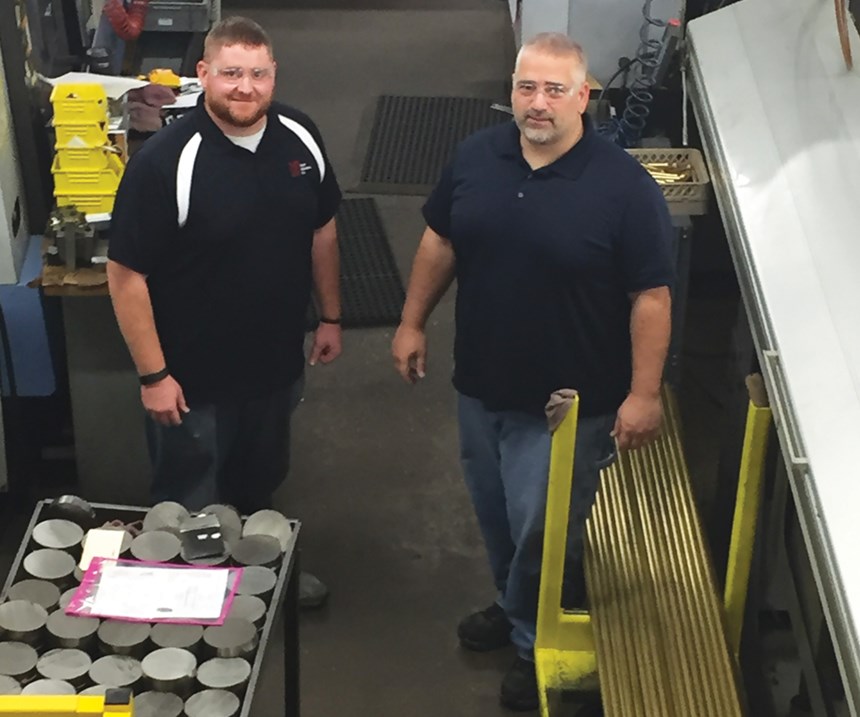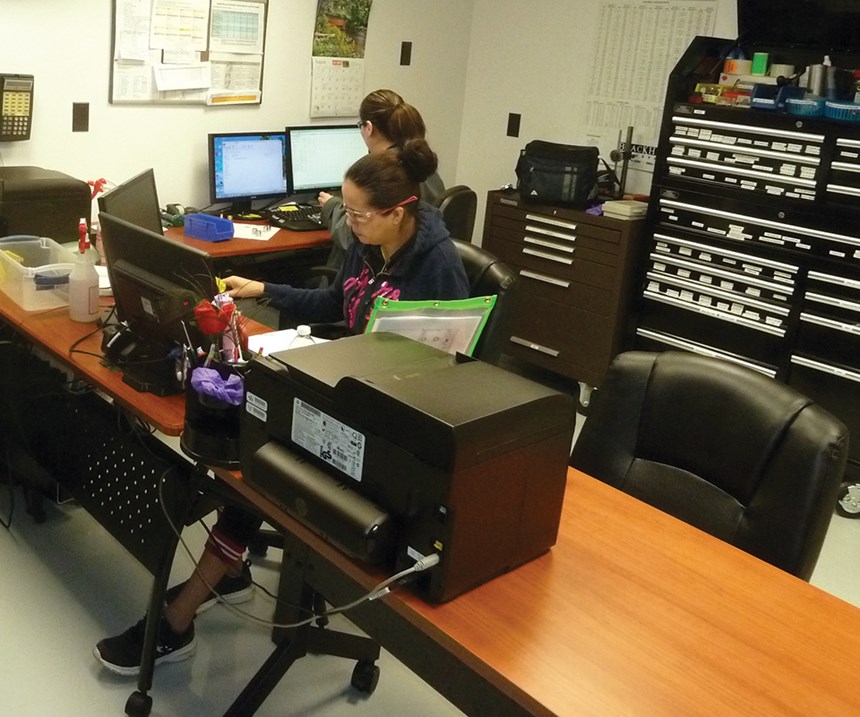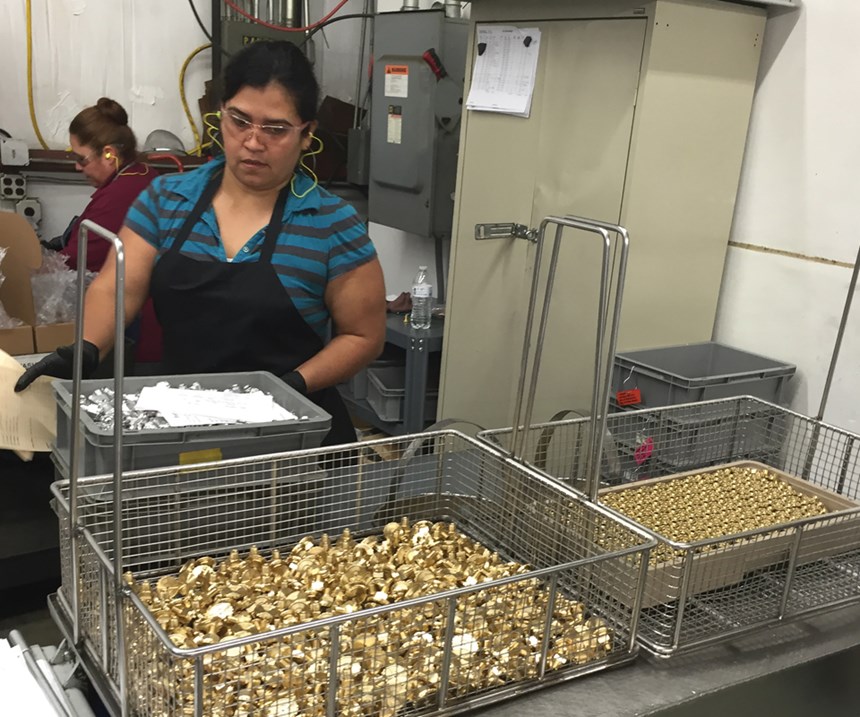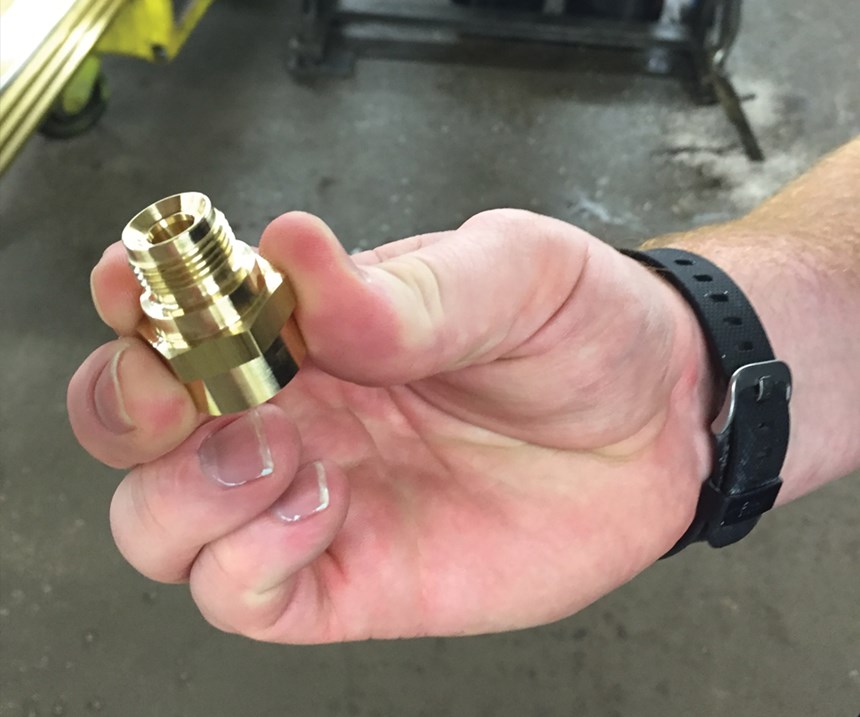Filling Bins While the Building is Empty
Over the past decade, technology has advanced to the point that lights-out machining is more seamless than ever before, with built-in safety systems and even the ability to switch from one part to another in the middle of the night.
In manufacturing, it’s a simple fact that if you’re not cutting chips, you’re not making money. So companies that are not running a third shift are losing a full eight hours of daily production, and even more on the weekends. Recovering that lost productivity was a primary impetus behind the development of lights-out machining in the late 1980s and early 1990s. In those days, however, the process presented quite a few challenges having to do with sustained quality and repeatability, and especially undetected tool failure during the unmanned hours that led to some nasty surprises when the first shift began. Before monitoring systems were developed that automatically shut down a machine should something go wrong, it would simply keep on churning out parts, resulting in dismayingly high scrap rates.
Technological advances in recent years have mostly eliminated these problems, revealing unexpected benefits as the process has become more reliable and robust. In addition to systems that automatically alarm out and shut down the machine at the first sign of a problem, which reduces scrap rates, quality has improved to the point that operators can rest assured that the last part produced will be an exact duplicate of the first. Equipment can also be programmed to switch from machining one part to another any number of times overnight, as long as the parts are within the same family and are cut from the same size barstock.
Slim Haney Machining has enjoyed a front-row seat to these ongoing developments, having delved into lights-out machining on its CNC Swiss-type lathe in 2008. The success of that endeavor led to outfitting a standard lathe for unmanned machining, and a third is currently going through trial runs, producing prototypes to dial in everything before going into production in the coming months. A review of the company’s experience—the challenges it faced early on, how they were overcome, the benefits it is now accruing, and the flexibility it has brought to the operation in terms of machine availability and allocation—provides a useful road map for any machine shop considering doing lights-out manufacturing.
Pursuing Production Efficiencies
Founded in 1962, and based in Tulsa, Oklahoma, Slim Haney Machining produces precision automatic screw machine products from brass, carbon steel, stainless, aluminum and plastics. Markets served include aerospace, medical, automotive, electrical, HVAC and fluid power systems. Because of an increasingly competitive market and rising employee healthcare costs, the company decided to identify and pursue processes and technologies that would lead to increased production efficiencies. As part of this process, it purchased a KSI Swiss-type CNC lathe in 2008 with the intention of introducing unmanned machining into its manufacturing operations.
A Swiss lathe is basically ready to perform lights-out machining as soon as it is installed, which is one of the best traits of any Swiss lathe. Most will come with a conveyor at the back end for transporting finished parts from the machine tool to a storage bin or parts washing operation, so the primary expense involves selecting a bar feeder that fits a particular application. In fact, any new user should invest in a quality magazine-style bar feeder from the start, according to Dennis Brock, vice president and general manager. It’s central to the process, he explains, and works better than a bar puller, which occupies a tooling position and has jaws that tend to wear and affect manipulation of the barstock. The investment will be returned in a matter of months, he adds. While this is good news for those who already have a Swiss lathe on the shop floor, the cost will be higher should the purchase of the machine tool be required as well, as was the case with Slim Haney.
Once the necessary equipment is in place to make conducting the process possible, Mr. Brock—who once worked as a commodity manager for a large manufacturer and traveled the world observing lights-out processes of all configurations—advises those who are learning about the procedure and thinking about incorporating it into their machining lineup to take the following into consideration:
Materials. Although Slim Haney is capable of working with a number of materials, it works primarily with brass, which is an ideal material for lights-out machining since it is softer and more forgiving than stainless steel, say, or other brittle metals that are more challenging to work with. Tools can become ineffective because of wear and can fail in the middle of the night. Should the tool wear, the targeted and achieved tolerances during setup can be lost, forcing an operator to re-examine the last parts that came off of the machine without knowing how far back to go in terms of identifying good parts and scrapping the rest. Not only is this a waste of materials, but it defeats the whole purpose of retrieving machine hours lost because of the lack of a third shift. Mr. Brock suggests having a detailed conversation with both machine tool OEMs and tooling suppliers about the materials planned to be cut as well as the final application of the part being machined.
Maintenance. Some companies may choose to have an operator on call to tend to any problems a machine encounters during the night, but that’s not always the case. For instance, Slim Haney has a rule that employees cannot enter the premises alone, meaning two people would have to attend to any late-night service calls. There is also the matter of how those people would be reimbursed for their time; some companies pay employees in minimum blocks of overtime, such as four hours, should an extra visit to the shop be required. The company’s approach is to allow the machine to alarm out and shut down should tool failure occur. The system doesn’t notify an employee if this happens, although cameras mounted throughout the facility allow machines to be monitored remotely at any time. In the case of a machine shutdown, a full report awaits the operator on their arrival, identifying the type of problem and where and when it took place.
Tooling. Depending on the configuration of the CNC Swiss lathe chosen—the number of spindles and turrets it features, for instance—operators can choose the quantity and type of tools they’ll need to have on hand. These will include turning tools, taps, drills and milling tools with inserts, along with live tooling should that option be chosen. Mr. Brock says tool design—along with the materials they are made of and even specialized coatings to protect against wear and to provide the desired surface finish—has progressed so far since lights-out machining first made its appearance on the shop floor about 10 years ago that tool failure is increasingly rare. While there are some Swiss lathes with tool checkers that automatically replace worn and/or broken tooling, a more common approach involves calculating how many workpieces a specific tool can be expected to machine with repeatability and providing fresh tools to be replaced during the night at pre-arranged points in the process; every 500th cycle, for instance. This is especially helpful when machining tough materials such as stainless steel.
Workpiece complexity. Generally, any part that a CNC Swiss lathe can produce is a candidate for lights-out machining, although simpler geometries lend themselves particularly well to unmanned machining since there is less chance of problems having to do with toolpath shifts or tooling failure. Mr. Brock says the ideal workpiece for lights-out Swiss machining is made of brass and in the basic shape of a bolt in range of 1 to 6 inches in length.
Cutting oil. Slim Haney worked with a number of companies that formulate custom cutting oils for Swiss machines in order to accomplish two things: identify a fluid that would extend tool life, particularly in lights-out situations, and that could also be used across a broad spectrum of machines and applications in order to minimize inventory.
By considering all of these factors in advance, a machine shop can be assured that the lathe of their choice delivers the power necessary for the intended application and that the tooling will perform as expected.
The Benefits Abound
When it comes to lights-out machining, it is fairly easy to imagine the many benefits associated with running a machine unattended, especially for companies involved in production manufacturing. Increased productivity is the primary reward, but there are other things to take into consideration as well. As Mr. Brock has mentioned, investing in a dependable, high-quality bar feeder will provide a return on investment in a matter of months, depending on the degree to which the machine is kept up and running. But there are other benefits as well, including the ability to fill unexpected orders or increases in the customer’s estimated annual usage (EAU). Slim Haney had a customer that estimated ordering 4,000 parts in the first year, only to end up needing approximately 40,000 in the first three or four months. Lights-out machining made it possible to meet this welcome, yet unexpected, increase in the scale of production.
Another advantage of lights-out involves resource allocation, meaning how and when particular projects are assigned to different machine tools. Lights-out machining provides the flexibility a machine shop requires when last-minute orders arrive, or when a customer requests a rush job on a batch of parts, small or large. Knowing a Swiss lathe can be run unmanned throughout the night makes other machines available to tackle unscheduled or emergency orders. And let’s face it, everybody wants to keep their customers happy, and nobody wants to turn down a lucrative order.
But the process still provides what it was originally developed to deliver: The ability to remain competitive in an increasingly crowded marketplace. To be able to keep filling parts bins long after the work crew has gone home for the evening can mean the difference between landing a new job or assigning it to the “no bid” file, and the advances in machine design, safety features and related CNC turning technologies has brought this process within range of almost any job shop, no matter the size of the operation.
For more information from Slim Haney Machining Inc., call 918-274-1082 or visit slimhaney.com
Related Content
Versatile Sandblasting for Deburring Intricate Geometries
PMTS 2023: Comco’s MicroBlasting sandblasting systems can deburr, texture and clean small, intricate parts.
Read MoreIn-line Monitoring for Automated Immersion Cleaning Systems
Ecoclean’s Acoustic Performance Measurement (APM) system provides in-line measurement of ultrasonic frequency and power in fully automated immersion cleaning systems on a batch-by-batch basis or at defined time intervals, such as once a shift, day or week.
Read MoreMeeting Stringent Cleaning Goals With Modular Ultrasonic System
A knee implant manufacturer implements an advanced cleaning system that meets its tight cleaning requirements, including documenting, validating and tracing the entire cleaning process.
Read MoreKyzen Solvents Provide Ease of Cleaning for Medical Parts
The Metalnox line of solvent products are designed to improve reliability and increase the ease of cleaning in vacuum and vapor degreasing processes.
Read MoreRead Next
5 Aspects of PMTS I Appreciate
The three-day edition of the 2025 Precision Machining Technology Show kicks off at the start of April. I’ll be there, and here are some reasons why.
Read MoreEmerging Leaders Nominations Now Open
Here’s your chance to highlight a young person in your manufacturing business who is on the path to be a future leader moving your company forward.
Read More
























